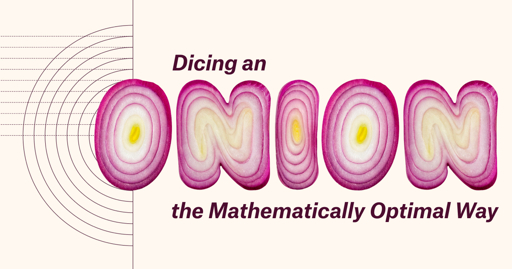Cool analysis if you happen to have cylindrical onions and infinitely long knives laying around.
I store them in the same non-euclidean drawer as my spherical cows.
Do not forget the tessaract
I keep mine next to my frictionless planes and point masses, but somtimes they roll away into the fourth dimension.
Oh. I have a soft spot for spherical cows.
Years ago I authored most of the Uncyclopedia page on the topic. Hehe. I see my edits there from 2010.
Extending the study to an onion’s actual shape, the conclusion would be conical cuts…
Banach-Tarski may be relevant here… https://en.m.wikipedia.org/wiki/Banach–Tarski_paradox
They also completely missed the point of the two additional cuts method and made the lowest cut about where the highest cut should be.
This is about making all the chunks the same size.
It’d be more useful to tell me the lowest possible number of cuts.
the lowest possible number of cuts for what?
Dicing an onion
What counts as diced though?
Being cut into approximately die-like pieces.
Is half-sphere close enough to die shape?
Cut off the bottom. Cut in half. Peel. Cut diagonal slices without separating from the root end. Both halves should still be intact, and the only exposed cut is where you cut off the end. Now every slice from the end will make a set of chopped pieces.
This is close to what I do. I cut the root end and the opposing end off, using the connecting bits to peel the onion. Then I stand it on the cut end and make vertical cuts down to about ½cm above the end of the onion, leaving everything connected. Rotate 90° and repeat until you’ve got a Bloomin’ Onion cut. Then turn the onion 90° on its side, and make vertical cuts again until you get to the part you didn’t dice. You can save this part for later quite easily, if you didn’t need a whole onion; otherwise place it on the cutting board, cut-face down, and dice in a grid pattern.
It doesn’t give you perfectly uniform sizes, and it’s not the fastest, but it’s a good midpoint between uniform and speedy.
Me:

Only way this’ll make ya cry is if you stuck your hand inside while chopping.

“You’re gonna love my nuts.”
I throw it up in the air and hit it with the cleaver twice, perfectly diced everytime
Tried this method. Any recommendations for repairing a broken window and getting a cleaver out of my neighbor’s dead body? It’s, like, really stuck in there.
And here I am using a food processor to chop my onions into little uniform bits.
Of all things you could learn in school after all the bullying and the huge tuition cost…
Ten years later…
A new mathematics field dedicated to slicing has resulted in 3D printable replacement heart and other vital organs.
why do all that when you could just do this? it’s much faster.
Besides the fast chopping, that guy also knows that his time is worth more than the piece of onion that he discards at the end.
my knife isnt sharp enough for this
if you cut an onion horizontally, you’re just fighting it’s already natural layers. no good onion cutting technique cuts horizontally imo
You can get around that by quartering the onion, making the vertical cuts, turning it so the vertical cuts are horizontal, then making more vertical cuts. :)
Here’s my fav way: https://yewtu.be/watch?v=CwRttSfnfcc
Very easy, imo!
For actual cooking, chop off the root part (it holds all the layers together), then perform two cuts to chop the onion in four equal pieces. Then press each quarter with your finger and it will separate into individual layers thin enough to fry in a pan.
You can even do it with two half-onions, but you’ll squish some layers when separating them, or you’ll spend too much time carefully separating them with a knife or a spoon.
Bad testing regime. Missed whole categories, food processor, mandolin, alternating depth, etc. Include time taken and clean up needed. I cut radial, alternating 50% depth and 100% depth cuts.
Using my mandolin where you slightly rotate the onion after each cut works wonderfully.
I’m not fully understanding the last bit, why alternating depths?
I think I get their point. The layers closest to the center of the onion have the smallest radius, so by only going all the way with every other cut, the smaller pieces toward the center of the onion get cut half as many times.
I just stick it in the whirry blade thing.
I have always said that the horizontal cuts were useless, I’m glad the math backs me up.
The horizontal cuts are supposed to go much lower. Look at the diagram again and imagine the cuts below the lowest cut they did.
I definitely do not care about dicing an onion uniformly, but I read and enjoyed the entire analysis.
All of the diagrams are of a cross-section of the middle of an onion. You know, it being round and all, it naively makes a lot of sense to assume that’s going to be ok as a model for the entire onion.
But … I find myself curious … if the solution is to cut to an angle below the onion, and the article did point out that a few pieces along the bottom would be mismatched … It seems that we are overlooking the top and bottom of the onion where sections are going to get some really weird looking cuts.
They say, “This is an onion. (Well, a simplified cross-section of one.)”
… No. No that is not an onion. Its not that they’ve chosen an easy problem, but the approximation used here is not an onion.












